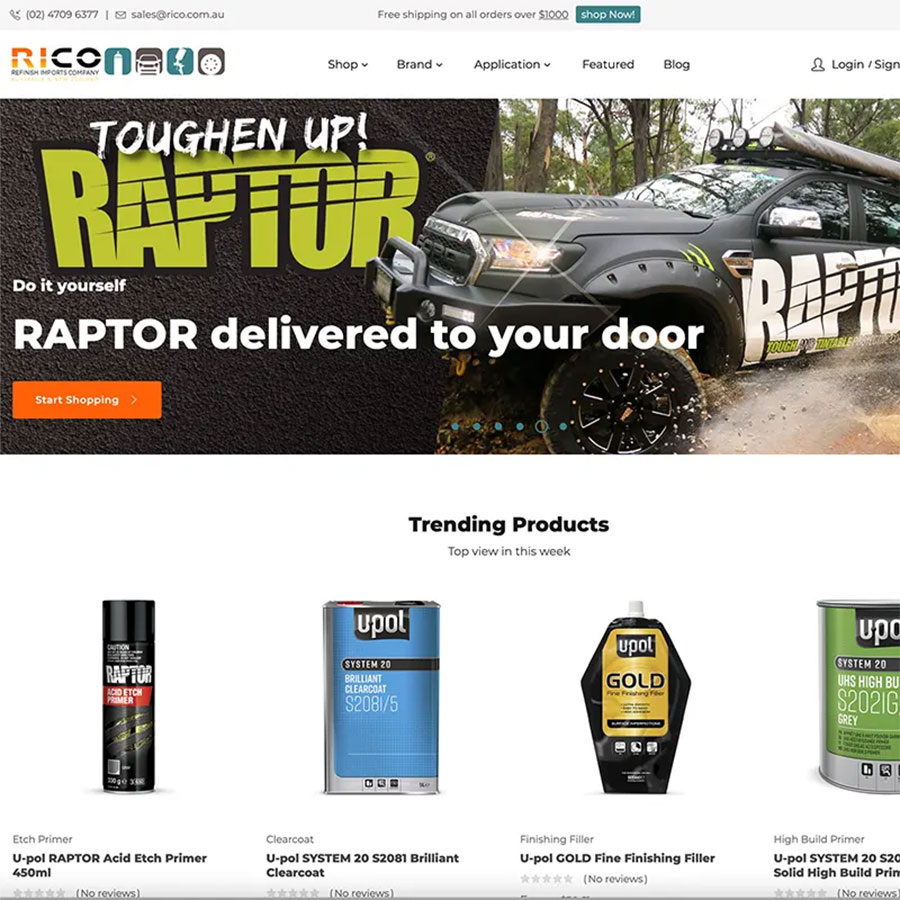20 August 2023
Online sales is a distribution method that involves selling products or services directly to customers through the internet. Online sales can be an alternative to traditional retail distribution, which usually involves intermediaries such as wholesalers, distributors, or retailers.
Online sales can offer advantages such as lower costs, wider reach, and more customization. However, online sales can also create potential channel conflicts between online sellers and other channels, such as physical stores or third-party platforms.

Refinish Imports web-shop: services both consumer (b2C) and business (b2b) markets
Online selling order fulfillment

Picking orders: At the warehouse, orders are "picked" by store people who walk the aisles and place products into their trolley. They consult a pick-list which lists the customer's ordered products. The pick-list is sequenced to match where the products are positioned in the warehouse. In many warehouses this process is automated.
"Selling products through the internet" is of course only half the story. Physical products sold this way need to be picked from storage, packed, labelled, and delivered. A process generally known as order fulfillment. Thus, instead of distributing products to "nicely turned out" retail outlets staffed by sales people, one only needs an unremarkable looking warehouse and some people to do the picking, packing, and dispatch.
The website is now the new shopfront - one that you don't have to drive across town to reach.
One of the biggest hurdles initially to online sales was consumer trust. Once my credit card is charged what proof do I have that the product will actually be delivered? And, if I don't like it or it arrives damaged how will I return it? Experience shows us that consumers have overcome this doubt and online sales are growing rapidly.
Outsourced order fulfillment and drop-shipping

Importers and distributors of products setting-up online shops already had the warehousing and dispatch operations in place, so setting-up an online shop only needed the development of the website (with a built-in web shop). However, for newcomers there are many 3rd parties that provide the warehousing and order fulfillment service. So called 3PL (3rd party logistics) companies exist that provide this service (for a fee).
Another option is "drop-shipping" where the original manufacturer (quite often located offshore) will ship direct to end-consumers overcoming the need for the owner of the e-commerce business to even buy the product in the first place (no investment in inventory) nor undertake the order fulfillment process.
Different types of online selling
There are various forms of online sales that can be categorized based on the type of seller, buyer, product, or service involved. Some common forms of online sales are:
-
Business-to-consumer (B2C) online sales: This is when a business sells its products or services directly to individual consumers through its own website or a third-party platform. Examples of B2C online sales are Amazon.com, Video streaming services such as Netflix, and custom built web shops set-up by individual businesses.
-
Business-to-business (B2B) online sales: This is when a business sells its products or services to another business through the internet. Examples of B2B online sales are Alibaba, Salesforce , and HubSpot.
-
Consumer-to-consumer (C2C) online sales: This is when an individual consumer sells his or her products or services to another consumer through an online marketplace or platform. Examples of C2C online sales are eBay, Carsales.com, Etsy and Airbnb.
-
Consumer-to-business (C2B) online sales: This is when an individual consumer sells his or her products or services to a business through the internet. Examples of C2B online sales are Upwork Fiverr, and Shutterstock.
Online sales is a dynamic and evolving distribution method that offers many opportunities and challenges for both sellers and buyers. As technology advances and consumer preferences change, online sales will continue to grow and diversify in the future.
B2B online selling description and examples
B2B online selling is a form of ecommerce that involves transactions between two businesses through the internet. Unlike B2C online selling, which targets individual consumers, B2B online selling caters to the needs and preferences of other businesses, such as wholesalers, retailers, resellers, or other organizations.
Some of the characteristics and benefits of B2B online selling are:
- Larger order sizes and higher average order values. B2B buyers typically purchase in bulk or on a recurring basis, which means more revenue and profit for the seller.
- Longer and more complex sales cycles. B2B buyers often require more information, negotiation, and approval before making a purchase decision, which means the seller needs to provide more support and communication throughout the process.
-
More personalized and customized offerings. B2B buyers expect the seller to tailor their products or services to their specific needs and specifications, which means the seller needs to be flexible and adaptable to different customer segments and scenarios.
-
Higher customer loyalty and retention. B2B buyers tend to stick with the same seller for a long time, as long as they are satisfied with the quality, price, and service they receive, which means the seller can build long-term relationships and repeat business.
Some of the challenges and obstacles of B2B online selling are:
-
Higher customer expectations and demands. B2B buyers have higher standards and requirements for the products or services they purchase, such as quality, reliability, security, compliance, and performance, which means the seller needs to meet or exceed those expectations consistently.
-
More competition and price pressure. B2B buyers have more options and access to information than ever before, which means the seller needs to differentiate themselves from their competitors and offer competitive pricing and value propositions.
-
More integration and automation needs. B2B buyers often use various systems and platforms to manage their business operations, such as enterprise resource planning (ERP), customer relationship management (CRM), or inventory management systems, which means the seller needs to integrate their online selling platform with those systems and automate their workflows.
Channel conflict: when pursuing an omni-channel distribution strategy leads to conflict
Many businesses have pursued a distribution strategy that mixes online sales with retail distribution.
Channel conflict is a situation where different channels that sell the same product or service compete with each other for customers, market share, or profits. Channel conflict can harm the relationships between the seller and its channel partners, reduce customer satisfaction, and lower sales performance. For example, if a manufacturer sells its products directly to consumers through its own website, it may undercut the prices of its retailers or distributors, who may feel betrayed or threatened by the direct competition. Alternatively, if a manufacturer sells its products through a third-party platform such as Amazon, it may lose control over its brand image, pricing strategy, customer relationship, or customer data.
However, channel conflict can often be initiated by the retail distributors when one of the retail distributors in a company's distribution network decides to open an online store in addition to their bricks and mortar retail outlet. Other retail distributors complain to their supplier that the online retailer is stealing their customers or undercutting their prices. This problem is exacerbated when bricks and mortar retail distributors have been assigned geographic territories to operate in.
Distributors complaining about channel conflict is real but can also (sometimes) be exaggerated and/or used as an excuse offered by the distributor for not meeting sales targets, a negotiation tactic to push for a discount, or simply an over reaction.
One lost sale can be enough to trigger a complaint when really it isn't a problem.
Physical distributors (particularly retail distributors) have many distinct competitive advantages over online sales. Having the product in stock so that it is available for immediate delivery, the customer can physically hold and examine the product prior to purchase, and customer service.
Retailers however, often negate these advantages at the first sign of losing sales to online competitors by reducing service staff (can't afford them), not stocking product ("but, we can order it in for you."), and dropping prices ("we have to - otherwise we will lose the sale"), hence the product becomes less profitable and attention is directed elsewhere.
But, equally it can't be denied that online sales have eaten into bricks and mortar retail business.
Online selling - subscription/membership services

The subscription model: The gift that keeps on giving.
One of the downsides to selling a product or service is potentially unpredictable or inconsistent revenue. A highly effective – and ever popular – way to overcome this is by offering a subscription service.
In B2C this often looks like providing the customer with added value in the form of members only prices, special offers, early access and/ or free shipping. In exchange for a regular payment.
For example, Amazon Prime generates over US$25 Billion in annual subscription revenue for Amazon.
For many online buyers, shipping costs can cause enough pause for them to reconsider the purchase. Prime users get free shipping, which removes this hurdle. Often leading to an increase in brand loyalty and more purchases per person annually than with non-prime subscribers.
In the B2B space, software subscriptions – also known as Software as a Service (SaaS) - are becoming the standard. Thanks to increased capability of cloud technology and consumer trust you no longer need to sell hard copies of software; you provide a subscription.
This provides consistent, reliable income to the software company while providing the subscriber with a consistent, fluid service that will always be up to date and won’t require additional purchases to access new versions.
However, the major pitfall to the subscription model is sustainability. Businesses can become too focused on increasing scale without ensuring their product is sustainable enough to both continually encourage new sign-ups and retain existing subscribers.
Selling online - the need to feed the beast through promotion
We all remember the dot-com bubble, also known as the Internet bubble, during the period from 1995 to 2000 characterized by a massive expansion and subsequent collapse of online businesses.
The fundamental flaw of many of these businesses was the assumption that potential consumers of their products (purchased via the internet) could be acquired cost effectively. However, an insufficient number of potential consumers were internet savvy and/or trusted buying online.
Typically, online businesses either failed because website traffic and sales conversions didn't eventuate or the amount of money they needed to spend advertising their website couldn't be sustained from sales.
Two notable exceptions of online businesses conceived during the DOT-COM bubble are AMAZON and e-Bay - both fabulous successes.
This is less of a problem now that the world has accepted the concept of buying online, a greater proportion of the population now use the internet daily, and the technology and methods are mature.
However, it is still often true that the margins saved by avoiding paying retailers (through their mark-ups) to sell their products is often replaced by the need to fund both the continuous cost of website development and updating and the cost of driving traffic to the online shop.
